This authentic tagliatelle Bolognese is rich and hearty! It's made with a savory blend of pancetta, ground beef, and pork simmered slowly in bone broth to develop a deep and complex flavor. To finish it off, the sauce is tossed in al dente pasta for the perfect bite!
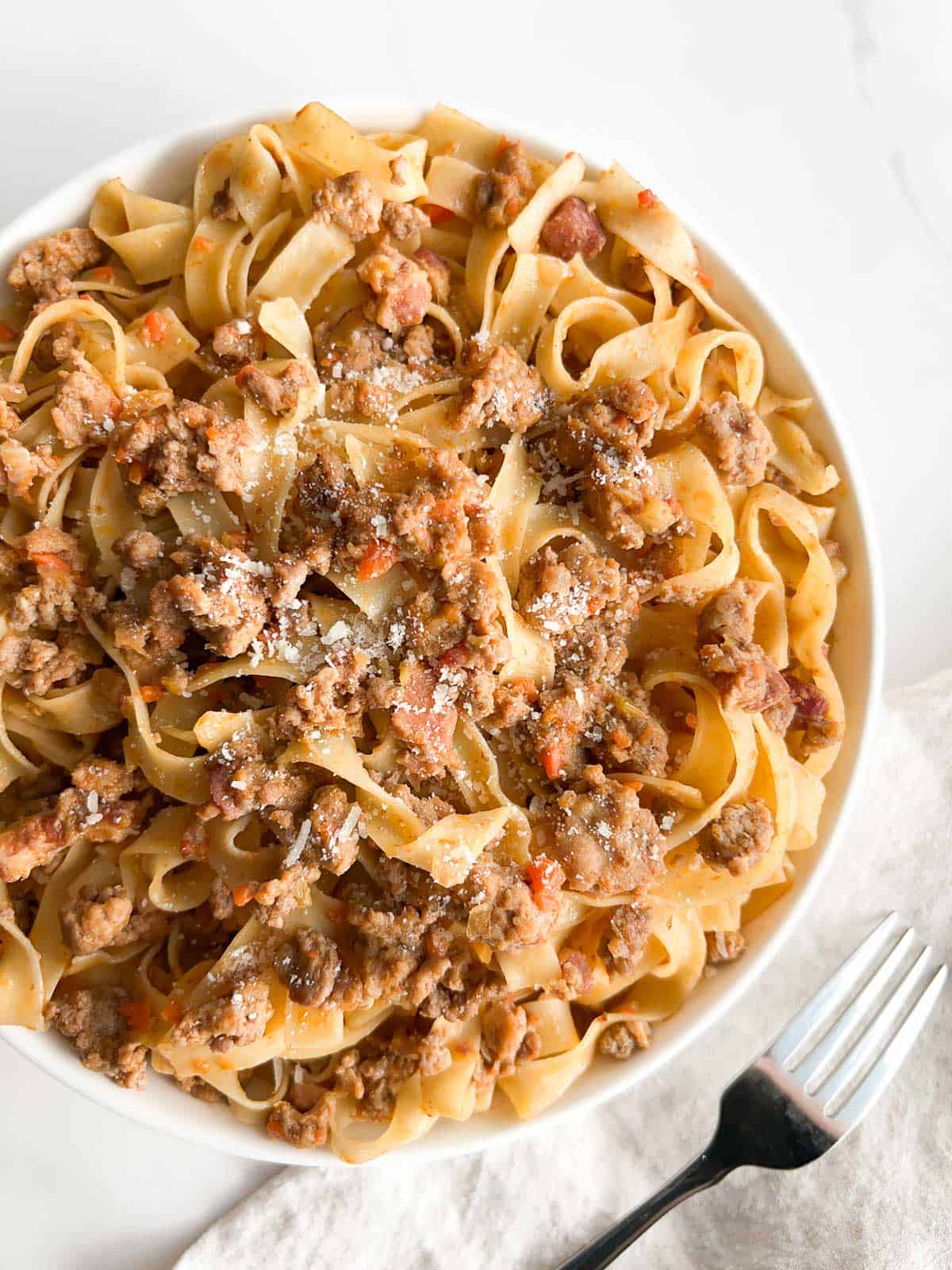
Save This Recipe! 💌
What is tagliatelle Bolognese? It's a classic Italian dish from Bologna, in the Emilia-Romagna region of Italy. It combines wide, flat pasta with a rich, slow-simmered meat sauce made from ground beef, pork, vegetables, and a touch of tomato and milk. In Italian it's known as "tagliatelle alla Bolognese."
Coming from an Italian family, we take our Bolognese very seriously. It needs to be hearty with an unbelievably complex flavor that develops over a long, low simmer on the stovetop. The simmer is a must, as you cannot achieve the deep flavor of an authentic Bolognese sauce without it. This recipe is extra special, since I'm sharing with you my family secret of using bone broth to simmer the sauce. It adds incredible flavor and depth!
Bolognese is the perfect comfort food for a slow Sunday afternoon or a weekend dinner party. It's easy to make, and the long simmer does all the work. Plus, your house will smell amazing! The richness of the Bolognese pairs well with a fresh salad, like this arugula and spinach salad or burrata caprese. I love to serve Bolognese with a slice of stirato bread, using it to soak up the extra meat sauce. An Italian dessert is the perfect way to end your meal, with this chocolate budino and pignoli cookies being delicious!
If you're looking for more hearty pasta recipes, check out this rigatoni al forno that's made with authentic San Marzano tomatoes and grass-fed beef. This authentic pasta e fagioli and baked ziti with sausage are both rich and comforting. You'll also love mushroom pappardelle that features hearty portobello mushrooms in a rich cream sauce. And for a classic favorite, you won't want to miss this cacio e pepe!
Jump to:
Ingredients

Ingredient Notes:
- Tagliatelle: this is a flat, wide egg pasta from the Emilia-Romagna region of Italy, the same area where Bolognese originates from. Tagliatelle is traditionally served with Bolognese because its slightly rough surface grabs the sauce, packing flavor into each bite. Since the dough contains eggs, it has a rich flavor and chewy texture that pairs well with hearty sauces.
- Pancetta: this forms the base of the sauce, giving it incredible flavor. I am picky about my pancetta since many cured meats contain unwanted additives and preservatives. I choose products that use pastured-raised pork, and only contain the ingredients of "pork, salt, and spices."
- Ground beef: I use beef with an 85% to 15% ratio of lean meat to fat. I find this has the perfect balance of flavor without adding too much grease to the sauce. I love using pasture-raised, grass-fed beef because it is more flavorful. It may also have higher levels of heart-healthy omega-3 fatty acids, antioxidants, and vitamins than conventional beef.
- Ground pork: like with the ground beef, I prefer using pasture-raised ground pork. In addition to having great flavor, pasture-raised pigs may produce more nutritious meat than conventional pigs. This may include higher levels of vitamins E and D.
- Carrot, celery, and yellow onion: I chop these finely so they incorporate into the sauce. The carrot, celery, and onion are known as a "soffritto" in Italian cuisine. Cooking the soffritto is an important step when making Bolognese sauce because the vegetables release a natural sweetness that forms a delicious foundation.
- Dry white wine: I prefer dry white wine because it adds a lighter acidity than red. This balances the richness of the sauce without overpowering it. Since the flavors come through in the final dish, I recommend using a high quality wine. Trebbiano di Romagno, Sauvignon Blanc, or Pinot Grigio are delicious options!
- Tomato paste: this is the only tomato product used in this Bolognese. Unlike American-style meat sauces, a true Bolognese only contains a touch of tomato. The meat is the star. I love using tomato paste because it gives a hint of flavor without overwhelming the sauce.
- Beef bone broth: it's my family secret to use bone broth. It's made by simmering bones over an extended period, giving it more flavor than a regular beef broth. The end result is a sauce with amazing depth and richness.
- Whole milk: yes, a true Bolognese sauce has some milk! It's added towards the end of the simmer time to tenderize the meat and add creaminess. Use room temperature milk to prevent it from curdling when added to the warm sauce. I love using grass-fed milk because it's richer and creamier than conventional milk. It may also have higher levels of omega-3 fatty acids.
See recipe card for quantities.
Substitutions and Variations
- Use a different pasta: you can substitute the tagliatelle with a pasta of your choice. Long, flat pasta that grabs the sauce works best. Fettuccine or pappardelle are great options. If you prefer a shorter pasta, cavatelli Bolognese is delicious because it pockets the sauce.
- Use bacon instead of pancetta: if you don't have pancetta available, you can use bacon instead. I recommend using thick cut bacon and dicing it. Since it's thinner than pancetta, you may need to adjust the cooking time accordingly. Bacon may be fattier, so you might need to drain the fat before cooking the soffritto.
- Use a different combination of ground meat: you can substitute the ground beef and pork with another meat of your choice. Ground veal is a great traditional option. You could also use ground turkey or chicken.
- Use red wine instead: you can substitute the white wine with a dry red wine. This may result in a darker colored sauce. The sauce will have a richer, more robust flavor with notes of berries and spices. Some delicious options are Chianti, Cabernet Sauvignon, or Sangiovese.
- Make dairy-free: you can omit the milk, butter, and Parmigiano Reggiano garnish if you prefer to make this dairy-free. Keep in mind the sauce will not be as creamy without the milk. You may need to add more bone broth towards the end of the simmer to prevent the sauce from sticking to the pot.
- Substitute the bone broth: if you don't have beef bone broth on hand, you can instead use regular beef, chicken, or vegetable broth. The sauce will not be as rich and complex, but will still be delicious!
Instructions

Step 1: in a large Dutch oven or heavy-bottomed pot, heat the olive oil and butter over medium heat. Add the pancetta and cook until it's crispy and the fat has rendered, or melted out (image 1). This will take about 5 minutes.

Step 2: add the carrot, celery, and onion to the pot with the pancetta. Cook for about 7 to 10 minutes, stirring often until the vegetables are softened. Then add the garlic and cook for one minute until fragrant (image 2).

Step 3: Add the ground beef and pork to the pot. Cook until browned, using a wooden spoon to break up the meat into smaller pieces (image 3).

Step 4: carefully pour in the wine. Deglaze the pot by using a wooden spoon to scrape up the browned bits on the bottom. Continue cooking until the wine has mostly evaporated (image 4).

Step 5: dilute the tomato paste with a small amount of bone broth. Pour it into the pot, cooking for 2 minutes until it caramelizes slightly (image 5).

Step 6: add the remaining bone broth and the bay leaf. Stir to combine (image 6).

Step 7: bring the sauce to a simmer and then lower the heat and allow the sauce to simmer gently uncovered for at least 1½ to 2 hours until it is thickened and flavorful (image 7). In a gentle simmer, the sauce should barely bubble. Stir occasionally and add more bone broth as needed if the sauce starts to stick to the bottom of the pot. Keep in mind that Bolognese is a thick and hearty sauce that should never be runny.

Step 8: about 30 minutes before the sauce is done simmering, pour in the milk slowly while stirring continuously. Then continue on a gentle simmer until the sauce reaches a rich and hearty consistency (image 8). Season with kosher salt to taste as needed.

Step 9: when the sauce is almost done simmering, bring a separate, large pot of water to a boil and stir in salt (image 9a). Add the tagliatelle and cook extra al dente, about 1 minute less than the package instructions (image 9b). Just before draining the pasta, reserve 1 cup of pasta water (image 9c). Then drain the pasta when ready (image 9d).

Step 10: remove the bay leaf from the sauce. Add the pasta to the pot of sauce, tossing until combined. Pour in a small amount of pasta water as needed to achieve your desired consistency (image 10). Remove the pot from the heat and serve immediately. Garnish with Parmigiano Reggiano and enjoy!
Storage & Reheating
You can store leftover tagliatelle bolognese in an airtight container in the refrigerator for up to 3 days. You can save and refrigerate a bit of pasta water to drizzle over the leftovers before reheating. I don't recommend freezing because the pasta can become mushy.
To reheat, drizzle a bit of pasta water over the leftovers. Then reheat the pasta in a skillet over medium-low heat or in the microwave in 30 second increments. The leftovers should reach a temperature of 165°F (74°C) before eating.
You can make the Bolognese sauce ahead of time. Follow the recipe as directed, but do not cook the pasta. You can store the sauce in an airtight container in the refrigerator for up to 3 days, or in the freezer for up to 3 months. If frozen, thaw overnight in the refrigerator before reheating. When ready to enjoy, heat up the sauce in a skillet over medium-low heat, until it reaches 165°F (74°C) throughout. Then cook the pasta and combine the sauce according to the recipe instructions.
For more information on how to handle leftovers safely, check out this helpful USDA Leftovers and Food Safety guide.
Expert tips
- Dilute the tomato paste with a bit of bone broth before adding it to the sauce. This makes it a smoother consistency that caramelizes well, prevents burning, and distributes the flavor evenly.
- Use a mix of meats for the best flavor. A combination of pancetta, ground beef and pork gives the sauce depth, complexity, and richness.
- Use room temperature milk to prevent it from curdling when added to the warm sauce. Pouring in the milk slowly while stirring the sauce continuously will also help to prevent curdling.
FAQ
Bolognese sauce, a traditional Italian ragu, is a rich, meat-based sauce. It's made with ground beef and pork simmered with a soffritto of onions, carrots, and celery. The sauce often includes wine and milk, resulting in a thick, hearty texture. In contrast, spaghetti sauce, commonly known as marinara sauce, is typically a tomato-based sauce that is simpler and less rich. It often includes garlic, onions, and herbs like basil and oregano. It may or may not contain meat.
If your Bolognese sauce is too thick, add a bit more bone broth, milk, or pasta water. Continue on a gentle simmer until it reaches your desired consistency. The sauce should be rich and hearty but not runny.
If your sauce is too thin, continue on a gentle simmer with the pot uncovered until more liquids evaporate and the sauce thickens.
Related
Looking for more delicious pasta recipes? Try these:
Pairing
These are my favorite dishes to serve tagliatelle Bolognese:
Did you make this recipe? Leave a star rating and comment below! For more recipes and Italian cooking tips, subscribe to my newsletter!
Recipe

Tagliatelle Bolognese
Save This Recipe! 💌
Ingredients
Bolognese:
- 1 tablespoon extra virgin olive oil
- 1 tablespoon unsalted butter
- 4 ounces pancetta (diced)*
- 1 carrot (peeled and finely diced)
- 1 celery stalk (one rib; finely diced)
- 1 medium yellow onion (finely diced)
- 2 cloves garlic (minced)
- 8 ounces ground beef *
- 8 ounces ground pork *
- ½ cup dry white wine *
- 2 tablespoons tomato paste
- 1¾ cups beef bone broth (divided into 1½ cups and ¼ cup portions; more may be needed as the sauce simmers)*
- 1 bay leaf
- 1 cup whole milk (room temperature)*
- kosher salt (to taste)
- Parmigiano Reggiano (grated, for garnish)
Pasta:
- 1 pound tagliatelle (dried)*
- 1½ tablespoons kosher salt
Instructions
- Cook the pancetta: in a large Dutch oven or heavy-bottomed pot, heat the olive oil and butter over medium heat. Add the pancetta and cook for about 5 minutes until crispy and the fat has rendered, or melted out.
- Cook the vegetables: add the carrot, celery, and onion to the pot with the pancetta. Cook for about 7 to 10 minutes, stirring often until the vegetables are softened. Then add the garlic and cook for another minute until fragrant.
- Cook the beef and pork: add the ground beef and pork to the pot. Cook until browned, breaking it up with a spoon as it cooks.
- Deglaze with white wine: carefully pour in the white wine. Deglaze the pot by using a wooden spoon to scrape up any browned bits from the bottom. Cook until the wine has mostly evaporated.
- Add the tomato paste: mix the tomato paste and ¼ cup of bone broth together until combined. Then stir the diluted tomato paste into the meat and vegetable mixture. Cook for 2 minutes to caramelize it slightly.
- Add the remaining broth and bay leaf: add the remaining 1½ cups of beef bone broth and the bay leaf. Stir to combine.
- Simmer the sauce: bring the sauce to a simmer. Then reduce the heat to low and let it simmer gently uncovered for at least 1½ to 2 hours, stirring occasionally until the sauce is thickened and flavorful. The sauce should barely bubble in a gentle simmer. Monitor the sauce and if it starts to stick to the bottom of the pan, add ¼ cup of bone broth or water at a time, stirring well until it reaches the desired consistency. Keep in mind that Bolognese is a thick and hearty sauce that should not be runny.
- Add the milk: about 30 minutes before the sauce is done, very slowly pour in the milk while stirring continuously. Continue to simmer gently until the sauce reaches a rich, hearty consistency. Add kosher salt to taste as needed.
- Cook the pasta: when the sauce is almost done simmering, bring a separate, large pot of water to a boil and stir in 1½ tablespoons of kosher salt. Add the tagliatelle and cook extra al dente, about 1 minute less than the package instructions. Just before draining the pasta, reserve 1 cup of the pasta water and set aside. Then drain the pasta when ready.
- Combine the pasta and sauce: remove the bay leaf and add the drained tagliatelle to the pot with the sauce. Toss together to combine. Add small amounts of pasta water as needed to reach your desired consistency. Then remove the pot from the heat and serve the pasta. Garnish with Parmigiano Reggiano and enjoy!
Video
Notes
- Pancetta: this can be substituted with bacon. I prefer diced, thick cut bacon. You may need to adjust the cooking time accordingly. Since bacon may be fattier than pancetta, you may wish to drain the excess fat before cooking the vegetables. You can also omit the pancetta altogether, but the sauce will be less rich.
- Ground beef and pork: you can substitute with a ground meat of your choice. Ground veal, turkey, or chicken are delicious options. Leaner cuts of meat like chicken may dry out with long simmers, so adjust the simmer time as needed to avoid overcooking.
- Dry white wine: I love using Trebbiano di Romagna, Sauvignon Blanc, or Pinot Grigio. You can also use a dry red wine instead. The sauce may be darker in color with a richer, more robust taste. Cabernet Sauvignon, Chianti, and Sangiovese are great red wine options.
- Beef bone broth: you can substitute with regular beef, chicken, or vegetable broth. The sauce will not be as rich, but will still be delicious!
- Whole milk: it's important that the milk is room temperature when adding it to the sauce to prevent it from curdling.
- Tagliatelle: you can use a different pasta of your choice. Bolognese goes best with long cuts of pasta that grab the sauce. Fettuccine and pappardelle are great options. If you prefer a shorter pasta, I love cavatelli Bolognese because it pockets the sauce.
- Fresh pasta conversion: you can substitute 1½ pounds of fresh pasta for every pound of dried. Since fresh pasta cooks faster, adjust the cooking time accordingly. Be careful when adding any extra pasta water in step 10 of the recipe because fresh pasta absorbs less water. Going slow will prevent the pasta from getting too watery.
- Make dairy-free: omit the butter, milk, and Parmigiano Reggiano garnish for a dairy-free version. The sauce will be less creamy without the milk. You may need to add more bone broth towards the end of the simmer time to prevent the sauce from sticking to the pot.
- Storage: leftover pasta can be stored in an airtight container in the refrigerator for up to 3 days. Refrigerate a bit of the pasta water to drizzle over the leftovers before reheating. I do not recommend freezing the pasta because it can become mushy.
- Reheating: drizzle a bit of pasta water over the leftovers. Then reheat in a skillet over medium-low heat, or in a microwave in 30-second increments until heated throughout. All leftovers should reach a temperature of at least 165°F (74°C) before eating.
- Make ahead: the sauce can be made ahead of time. Follow the recipe as directed, but do not cook the pasta. Store the sauce in an airtight container in the refrigerator for up to 3 days or in the freezer for up to 3 months. If frozen, allow to thaw in the refrigerator overnight before reheating. When ready to enjoy, heat the sauce in a large skillet over medium-low heat until it reaches 165°F (74°C) throughout. Then cook the pasta and combine it with the sauce per the recipe instructions (steps 9 and 10).
Nutrition
The provided nutrition and storage information is estimated. Accuracy is not guaranteed.
See our Disclaimer for more information.
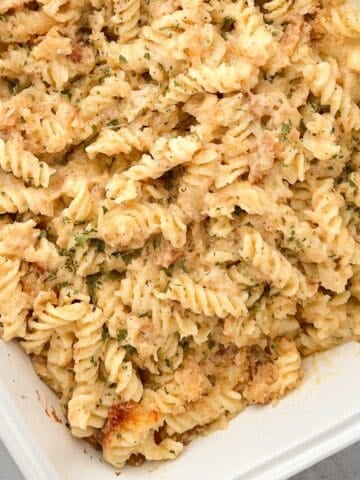
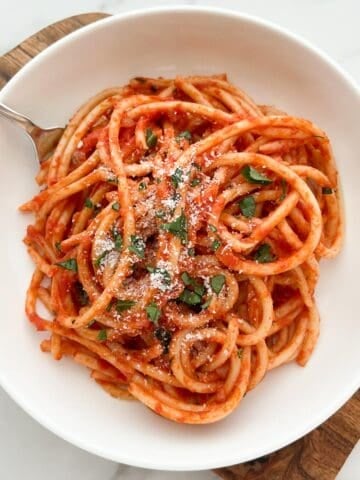
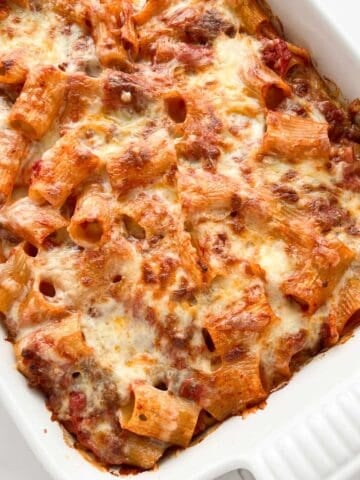
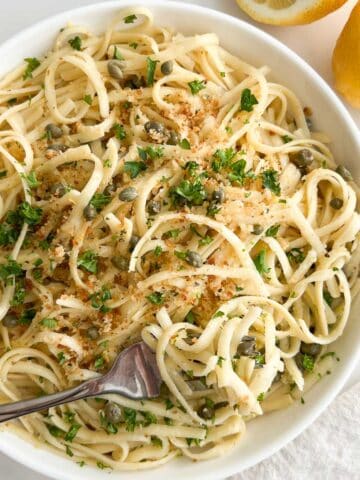
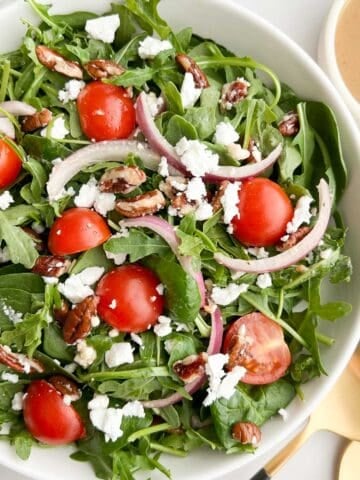

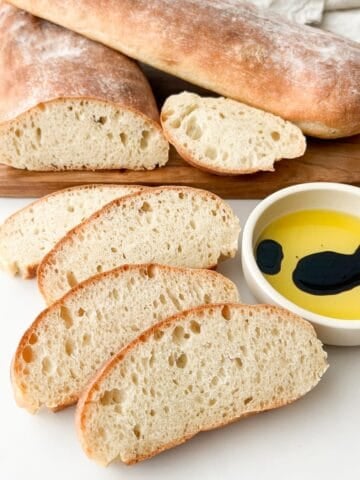
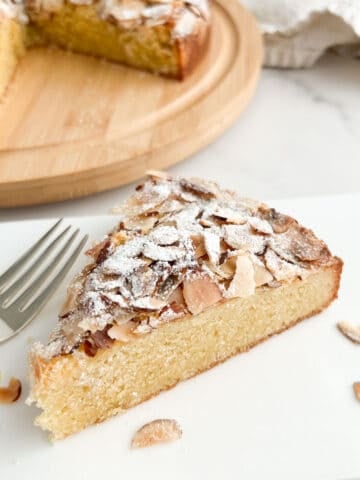










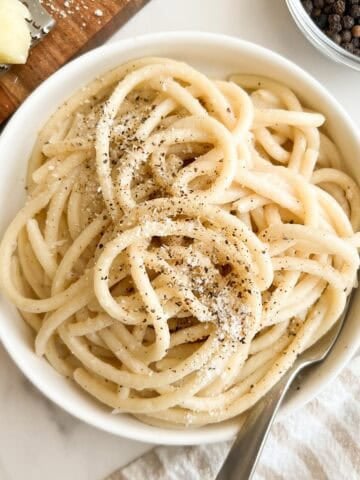
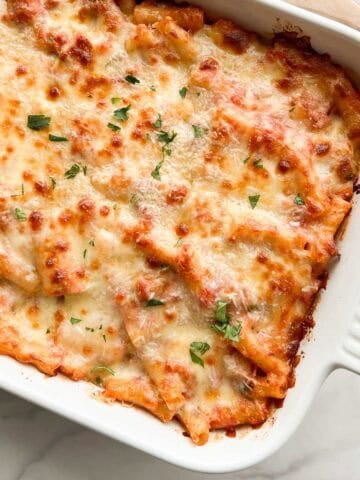
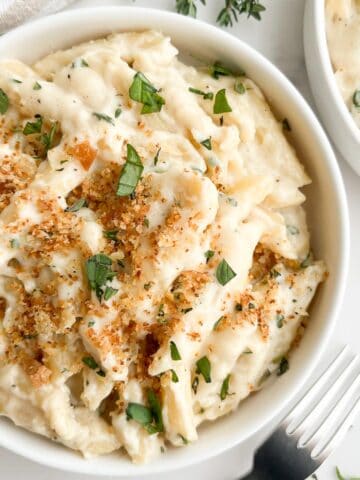
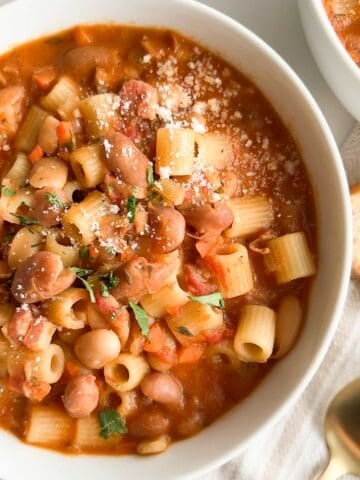
rd says
This pasta dish is wonderful, and brings back fond memories of my childhood. The sauce slowly simmering, the house smelling of Italian spices…I was pleasantly surprised how straightforward this recipe is to make. The flavors are rich and complex, yet it eats light and refreshing. The pancetta adds a smoky, savory bite to the sauce, and tagliatelle is a perfect pasta to showcase the charm of this ragú. This dinner is an absolute family-pleaser, and I know yours will love it just as much as mine.
Maria D'Errico says
I'm so happy you love the recipe and that it brought back fond memories of your childhood!